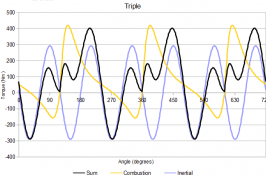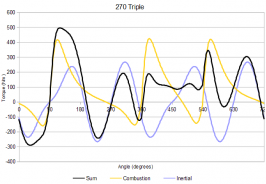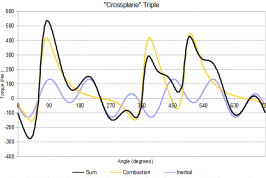You are using an out of date browser. It may not display this or other websites correctly.
You should upgrade or use an alternative browser.
You should upgrade or use an alternative browser.
Why is it 8 the magic number to get that deep growling engine sound?
- Thread starter furryboy96
- 38 comments
- 14,708 views
- 8,723
Just thought I'd draw attention to something I mentioned previously about how the harmonics of an engine sound dominate our perception.
Specifically, I mentioned that a 288° twin would sound like a 5 cylinder, in a way.
288° is twice 144°, which is 720° (four strokes) divided by 5. The reason I chose 288-432 and not 144-576 is because 144° contains more harmonics and is therefore less distinct; 288 plus 144 is already 432. This is analogous to pickup placement on an electric guitar: the closer to the bridge (where waves in the strings are reflected; like the loop point in a cycle), the more harmonics are captured, but the less "meaty" the sound is.
Well, anyway, KTM have had 75 degree V-Twins for a while and their new "parallel" twin apes these with a 285° crank. The compact packaging of the inline arrangement compared to the V allows for better preserving of the harmonic structure inherent to the firing intervals (remember any unevenness, like in the boxer, can create a different structure altogether)
And so it seems that their 790 Duke, with its 285-435 degree firing intervals, does indeed have a strong five cylinder vibe from the midrange on. Although perhaps the unevenness is more reminiscent of an "odd-fire" V10, like a Viper or R8 / Gallardo / Huracán:
(Edited as original video was deleted)

Specifically, I mentioned that a 288° twin would sound like a 5 cylinder, in a way.
288° is twice 144°, which is 720° (four strokes) divided by 5. The reason I chose 288-432 and not 144-576 is because 144° contains more harmonics and is therefore less distinct; 288 plus 144 is already 432. This is analogous to pickup placement on an electric guitar: the closer to the bridge (where waves in the strings are reflected; like the loop point in a cycle), the more harmonics are captured, but the less "meaty" the sound is.
Well, anyway, KTM have had 75 degree V-Twins for a while and their new "parallel" twin apes these with a 285° crank. The compact packaging of the inline arrangement compared to the V allows for better preserving of the harmonic structure inherent to the firing intervals (remember any unevenness, like in the boxer, can create a different structure altogether)
And so it seems that their 790 Duke, with its 285-435 degree firing intervals, does indeed have a strong five cylinder vibe from the midrange on. Although perhaps the unevenness is more reminiscent of an "odd-fire" V10, like a Viper or R8 / Gallardo / Huracán:
(Edited as original video was deleted)

Last edited:
- 27,219

- United Kingdom
I do see what you mean about that - been a while since I've driven an RS3 or R8 so I couldn't hear the similarity at first, but compared with a few videos there's definitely a similar tone to it.
- 11,918

- Marin County
That is very interesting. It retains the 'texture' of a twin, but I definitely do hear a kind of V10 'bassline'.
- 8,723
Yeah, it's pretty subtle - I most notice what I'd call an overtone. That smooth howl over the top of the lumpy twin texture. I think it's most noticeable from 4:40 in the above video, although it takes me a little while to tune into it each time.
A triple (near 288-288-144) would be more distinct, but there's no chance anyone will make it.
A triple (near 288-288-144) would be more distinct, but there's no chance anyone will make it.
- 8,723
Triumph Motorcycles announced earlier this year that their new bored-out 900 cc Tiger "Adventure" bike uses what they call a "T-Plane" crankshaft.
In any case, the firing intervals are a crossplane-V8-like 270-270-180.
Here's a comparison of the old even-firing triple and the new engine:
And a slightly more in-your-face demonstration:
Triumph claim the configuration leads to a better connected feel to what's happening at the rear tyre, but it doesn't seem like it should be the case from the inertial torque characteristics. So any improvement must really be a result of the extra (combustion) torque from the extra displacement in combination with the lack of the peaky even-firing delivery.




~100 Nm / litre & 200 bhp / litre @ 14 000 rpm, 400 g reciprocating mass, 81 x 48.5 mm bore / stroke, 2:1 rod.
The "Crossplane" Triple here is my interpretation of the minimisation of inertial torque for a three cylinder engine - it would use a different crank configuration, despite the name. It should be clear how the "T-Plane" (270 Triple) engine does not really achieve the inertial torque isolation that might result in significantly better throttle / wheel connection / feel.
In any case, the firing intervals are a crossplane-V8-like 270-270-180.
Here's a comparison of the old even-firing triple and the new engine:
And a slightly more in-your-face demonstration:
Triumph claim the configuration leads to a better connected feel to what's happening at the rear tyre, but it doesn't seem like it should be the case from the inertial torque characteristics. So any improvement must really be a result of the extra (combustion) torque from the extra displacement in combination with the lack of the peaky even-firing delivery.




~100 Nm / litre & 200 bhp / litre @ 14 000 rpm, 400 g reciprocating mass, 81 x 48.5 mm bore / stroke, 2:1 rod.
The "Crossplane" Triple here is my interpretation of the minimisation of inertial torque for a three cylinder engine - it would use a different crank configuration, despite the name. It should be clear how the "T-Plane" (270 Triple) engine does not really achieve the inertial torque isolation that might result in significantly better throttle / wheel connection / feel.
- 30,028

- a baby, candy, it's like taking.
- TexRex72
"T-Plane"

- 4,018

- Null Island
*snip*
*Autot-u-u-u-u-ne intensifies*
Similar threads
- Replies
- 10
- Views
- 5K
- Replies
- 16
- Views
- 2K
- Replies
- 12
- Views
- 2K


